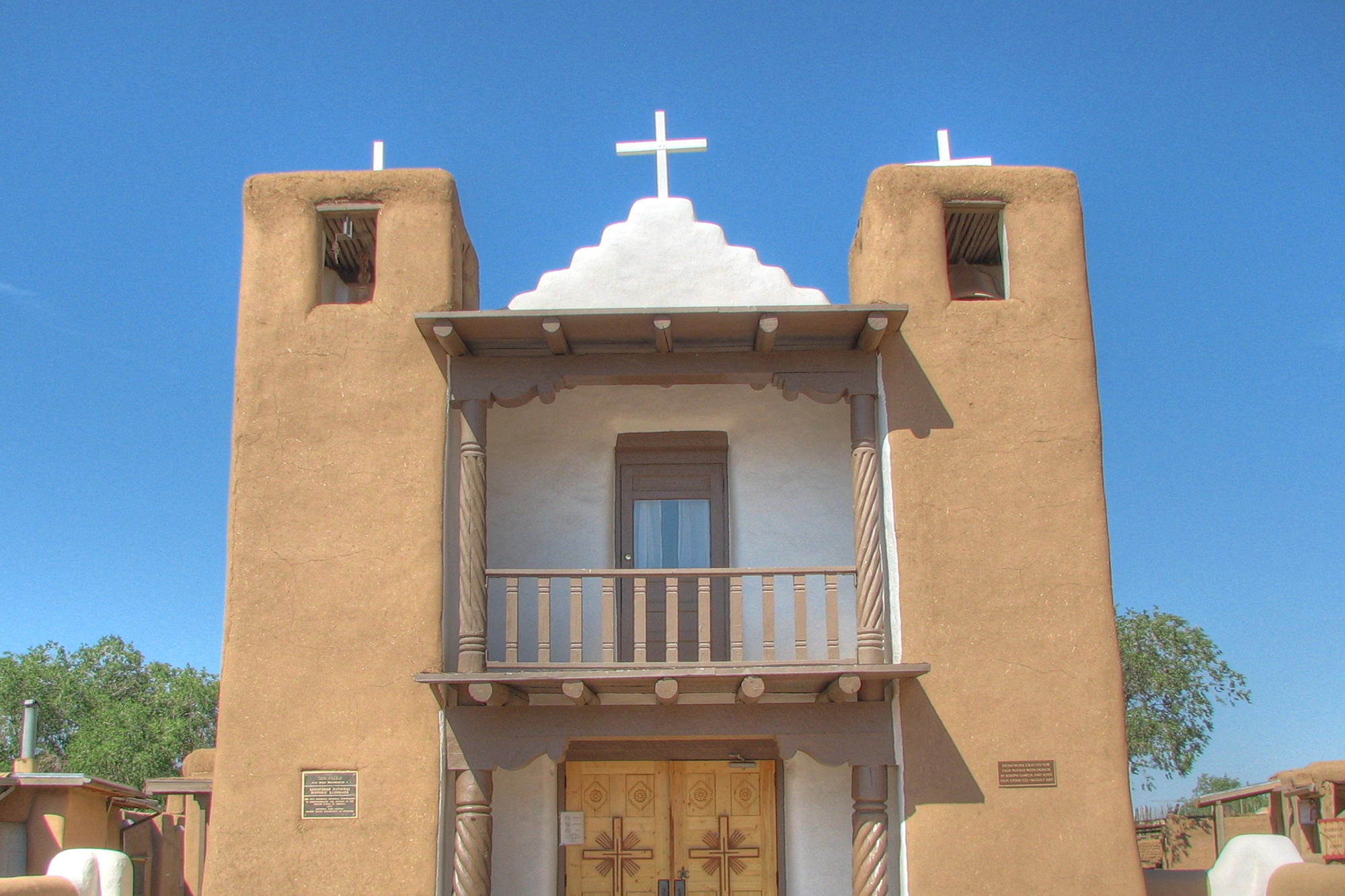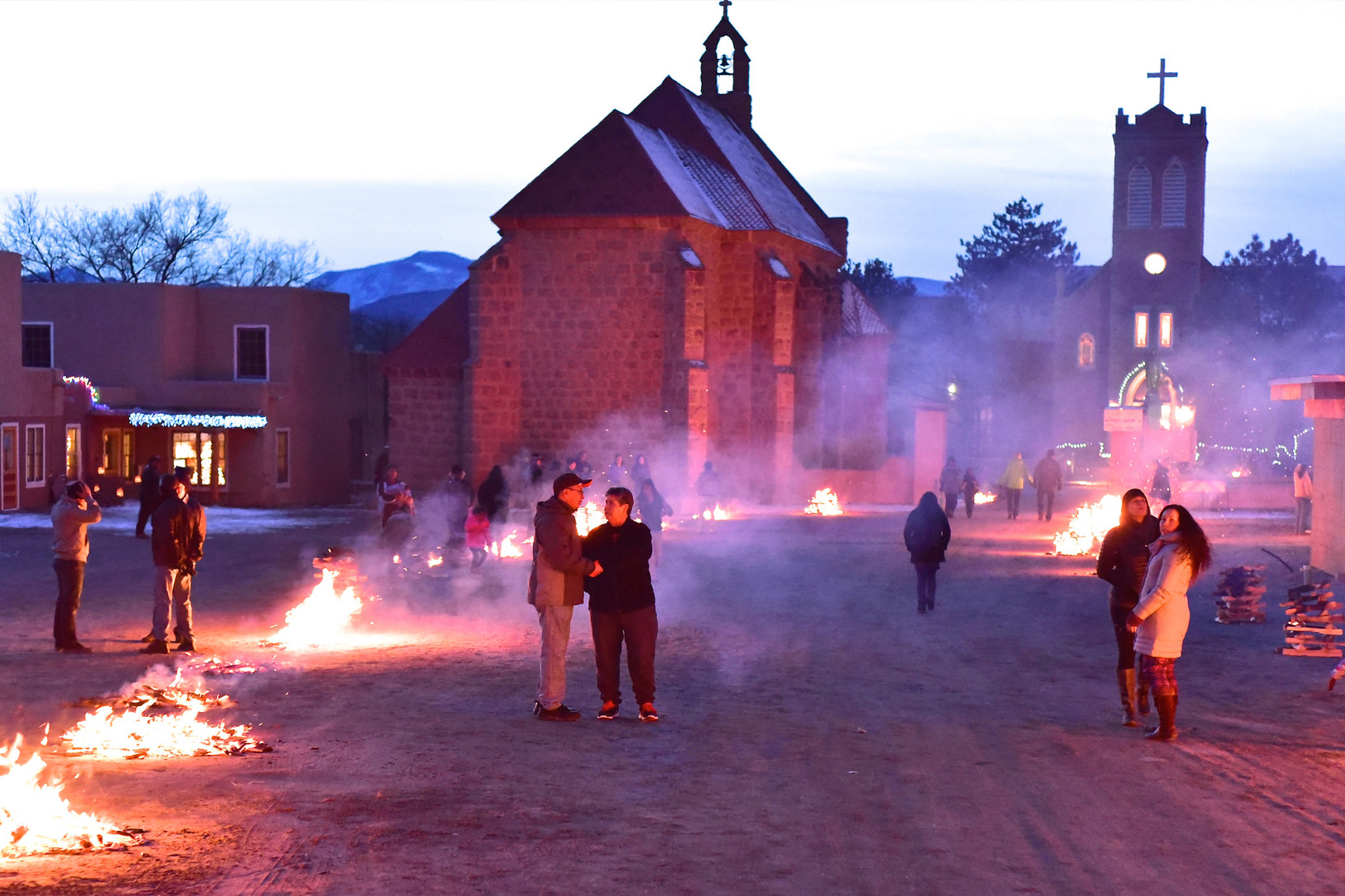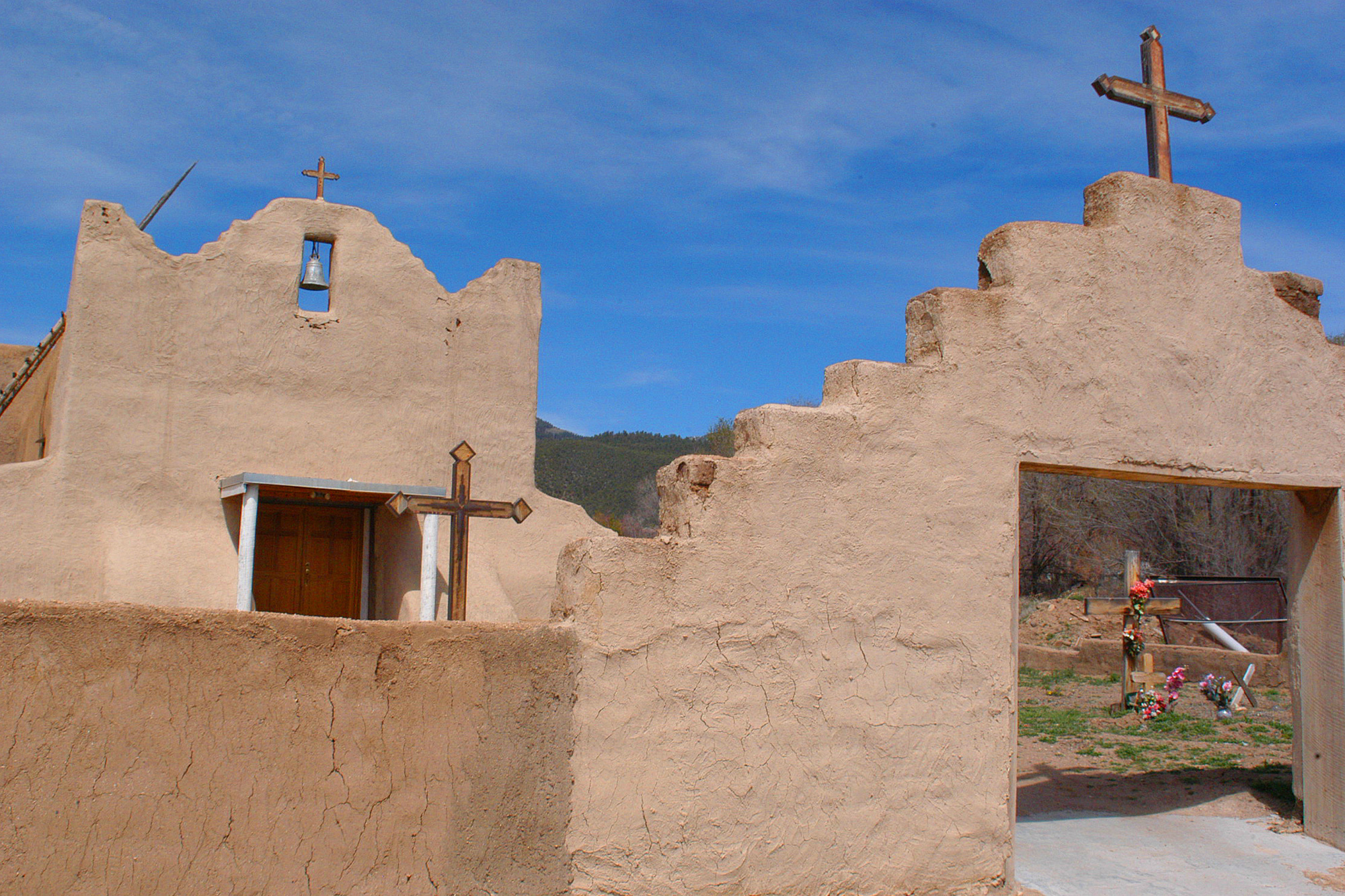Some of these buildings are so old that histories are strictly oral, causing inaccuracies and fuzzy dates. No matter what their exact origin, they are absolutely marvelous. So, if you are looking for a new adventure steeped in history and beauty, follow along on our tour of New Mexico’s great architectural works of art. What follows is a true adventure guaranteed to feed your soul.

SAN FRANCISCO DE ASIS MISSION CHURCH –
RANCHOS DE TAOS
On the main plaza of Ranchos de Taos is the beautiful San Francisco de Asis Mission Church. Built between the late 1700s and early 1800s, it is an impressive architectural blend of Native and Spanish styles that has inspired artists such as Georgia O’Keeffe, Ansel Adams, and Paul Stand for centuries. O’Keeffe described the church as “one of the most beautiful buildings left in the United States by the early Spaniards.” In June, visitors can witness the annual “Enjarre,” or re-mudding, of the church by community volunteers.

SAN GERONIMO CHAPEL – TAOS
Near the entrance of the Taos Pueblo, one of the longest continuously inhabited communities in America, sits the present-day San Geronimo Chapel. The original structure was built in the 17th century but was destroyed and recreated until the mid-19th century – the church that stands today was built in 1850, though the ruins of the original structure remains. Visiting the pueblo and neighboring chapel is noted as one of the best Native experiences in the U.S.

LORETTO CHAPEL – SANTA FE
Under the same architect as the St. Francis Cathedral Basilica, construction of the chapel began in 1873. Unfortunately, the architect died before access to the choir loft was built. According to legend, the Sisters of Loretto prayed a nine-day novena to St. Joseph, Patron Saint of Carpenters, and on the ninth day, it’s said a mysterious man appeared and built the chapel’s miraculous staircase with two 360-degree turns, no visible means of support, and wooden pegs instead of metal nails. Many believe the man was St. Joseph himself. The Loretto Chapel is now a museum and wedding destination.

SAN MIGUEL CHAPEL – SANTA FE
Built somewhere between 1610 and 1628, the San Miguel Chapel is believed to be the oldest church structure in the continental U.S. Located just south of the Santa Fe plaza, the modest adobe church is rich with history and unassuming beauty. The San Miguel Chapel is also full of beautiful artwork, including the oldest reredos – wooden altar screens—in New Mexico and works by the “Laguna Santero,” an anonymous but highly influential artist. The chapel is still open during most of the week for prayers and visitors.

THE CATHEDRAL BASILICA OF ST. FRANCIS OF ASSISI – SANTA FE
The St. Francis Cathedral is a centerpiece of Santa Fe life, culture, and heritage. While the stunning structure that stands today was commissioned in 1850 by Santa Fe’s first bishop and is still very much in use today, the original small adobe church that stood in its stead was built in 1626. In 2005, the Cathedral was elevated to a Basilica by Pope Benedict XVI because of its important role and history of spreading Catholicism. The cathedral was also memorialized in Willa Cather’s 1927 novel, Death Comes for the Archbishop.

EL SANTUARIO DE CHIMAYÓ – CHIMAYÓ
In the village of Chimayó along the High Road to Taos is El Santuario de Chimayó, a cherished national historic landmark and one of the most important Catholic pilgrimage sites in the United States. The sanctuary receives around 300,000 visitors per year — thousands during Holy Week alone as people make their way to the church as a demonstration of their faith. It is also known as the “Lourdes of America” for the healing soil located in a small round hole in a prayer room next to the sanctuary. Today, many people come to the church seeking this soil, hoping to cure their afflictions.

SAN JUAN CHURCH – OHKAY OWINGEH
Although the oldest Catholic Church structure in the U.S. is the San Miguel Chapel in Santa Fe, a little-known fact is the first and oldest Catholic parish in the United States is also located in New Mexico: the San Juan Bautista, established around 1598. The parish is located on the Ohkay Owingeh Pueblo about 30 miles north of Santa Fe and is still thriving. The modern parish boasts choirs in Spanish, English, and the Native language, Tewa.

SAN FELIPE DE NERI CHURCH – ALBUQUERQUE
Located on the north side of the Old Town Plaza in the heart of Albuquerque is the San Felipe de Neri Church, one of the oldest surviving buildings in the city. The present-day church was built in 1793 after the original structure circa 1706 collapsed in 1792 during a very rainy summer. More European-style accents, such as its distinctive belltowers, were added in the mid-19th century to reflect fashionable church construction of the 1860s.

SAN JOSE DE GRACIA CHURCH – LAS TRAMPAS
Built between 1760 and 1766, the San Jose de Gracia Church is the hallmark of Las Trampas. Designated a National Historic Landmark in 1970, the church is acclaimed as a model of the adobe architecture found throughout the state and one of the best-preserved examples of Spanish Colonial churches found in New Mexico and it’s the only Spanish Colonial building left intact within the Las Trampas Historic District.

SANTA CRUZ DE LA CAÑADA CHURCH – SANTA CRUZ
Once one of the largest, most impressive adobe mission churches in New Mexico, the Santa Cruz de la Cañada Church was built in 1733 after the original chapel used by Spanish settlers was destroyed due to flooding by the nearby river. The present-day structure was completed in 1748. In addition to its impressive architecture, the inside of the church contains beautiful examples of Spanish Colonial art, including one of the earliest Spanish Colonial artworks painted by Fray Andres Garcia between 1765 and 1768. Today, the church is an active house of worship and one of Northern New Mexico’s largest surviving adobe churches from the Spanish Colonial period.

SAN LORENZO DE PICURIS MISSION CHURCH – PICURIS PUEBLO
Located in the center of one of New Mexico’s smallest pueblos is the San Lorenzo de Picuris Mission Church. It is believed the original mission church was built around 1620 by Franciscan priests, but due to numerous conflicts between the Spanish colonialists and the pueblo’s inhabitants, the mission was destroyed and rebuilt several times. Today, the San Lorenzo de Picuris has been restored by the Picuris community and hosts the pueblo’s major feast day, San Lorenzo Feast Day, every August.


